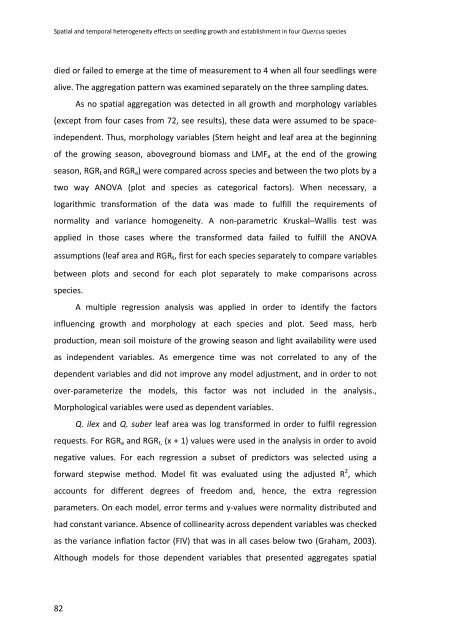Establecimiento de cuatro especies de Quercus en el sur de la ...
Establecimiento de cuatro especies de Quercus en el sur de la ...
Establecimiento de cuatro especies de Quercus en el sur de la ...
Create successful ePaper yourself
Turn your PDF publications into a flip-book with our unique Google optimized e-Paper software.
Spatial and temporal heterog<strong>en</strong>eity effects on seedling growth and establishm<strong>en</strong>t in four <strong>Quercus</strong> species<br />
died or failed to emerge at the time of mea<strong>sur</strong>em<strong>en</strong>t to 4 wh<strong>en</strong> all four seedlings were<br />
alive. The aggregation pattern was examined separat<strong>el</strong>y on the three sampling dates.<br />
As no spatial aggregation was <strong>de</strong>tected in all growth and morphology variables<br />
(except from four cases from 72, see results), these data were assumed to be spacein<strong>de</strong>p<strong>en</strong><strong>de</strong>nt.<br />
Thus, morphology variables (Stem height and leaf area at the beginning<br />
of the growing season, aboveground biomass and LMF a at the <strong>en</strong>d of the growing<br />
season, RGR t and RGR a ) were compared across species and betwe<strong>en</strong> the two plots by a<br />
two way ANOVA (plot and species as categorical factors). Wh<strong>en</strong> necessary, a<br />
logarithmic transformation of the data was ma<strong>de</strong> to fulfill the requirem<strong>en</strong>ts of<br />
normality and variance homog<strong>en</strong>eity. A non‐parametric Kruskal–Wallis test was<br />
applied in those cases where the transformed data failed to fulfill the ANOVA<br />
assumptions (leaf area and RGR t , first for each species separat<strong>el</strong>y to compare variables<br />
betwe<strong>en</strong> plots and second for each plot separat<strong>el</strong>y to make comparisons across<br />
species.<br />
A multiple regression analysis was applied in or<strong>de</strong>r to i<strong>de</strong>ntify the factors<br />
influ<strong>en</strong>cing growth and morphology at each species and plot. Seed mass, herb<br />
production, mean soil moisture of the growing season and light avai<strong>la</strong>bility were used<br />
as in<strong>de</strong>p<strong>en</strong><strong>de</strong>nt variables. As emerg<strong>en</strong>ce time was not corr<strong>el</strong>ated to any of the<br />
<strong>de</strong>p<strong>en</strong><strong>de</strong>nt variables and did not improve any mo<strong>de</strong>l adjustm<strong>en</strong>t, and in or<strong>de</strong>r to not<br />
over‐parameterize the mo<strong>de</strong>ls, this factor was not inclu<strong>de</strong>d in the analysis.,<br />
Morphological variables were used as <strong>de</strong>p<strong>en</strong><strong>de</strong>nt variables.<br />
Q. ilex and Q. suber leaf area was log transformed in or<strong>de</strong>r to fulfil regression<br />
requests. For RGR a and RGR t, (x + 1) values were used in the analysis in or<strong>de</strong>r to avoid<br />
negative values. For each regression a subset of predictors was s<strong>el</strong>ected using a<br />
forward stepwise method. Mo<strong>de</strong>l fit was evaluated using the adjusted R 2 , which<br />
accounts for differ<strong>en</strong>t <strong>de</strong>grees of freedom and, h<strong>en</strong>ce, the extra regression<br />
parameters. On each mo<strong>de</strong>l, error terms and y‐values were normality distributed and<br />
had constant variance. Abs<strong>en</strong>ce of collinearity across <strong>de</strong>p<strong>en</strong><strong>de</strong>nt variables was checked<br />
as the variance inf<strong>la</strong>tion factor (FIV) that was in all cases b<strong>el</strong>ow two (Graham, 2003).<br />
Although mo<strong>de</strong>ls for those <strong>de</strong>p<strong>en</strong><strong>de</strong>nt variables that pres<strong>en</strong>ted aggregates spatial<br />
82

















